Quella di Gerhard Richter alla Tate Modern è una mostra indimenticabile. Lo sapevo già prima di andarci, visto che si tratta della prima grande antologica sul pittore tedesco, eppure la conferma non è stata priva di sorprese. Indimenticabile perché la grandezza di Richter ha lo spazio per dispiegarsi nonostante i limiti che un allestimento come quello della Tate, inevitabilmente, porta con sé.
La mostra ha un andamento didattico, giustamente cronologico, ma rinuncia o non è stata capace, laddove era possibile, a far deflagrare alcune questioni esplosive insite nell’arte di Richter. Diciamola così: secondo la distinzione che Giovanni Agosti mutua da Pasolini, quella alla Tate è una mostra di prosa e non di poesia.
Faccio quattro esempi: il primo è nella seconda sala, quando il rapporto tra “Herr Heyde” (1965) e “Tante Marianne” (1965) non è affatto valorizzato. Il primo quadro, infatti, rappresenta l’arresto del responsabile della politica eugenetica del regime nazista, mentre il secondo è la riproduzione di un immagine in cui Richter bambino è tenuto in braccio dalla zia Marianne, vittima proprio di quella politica. I quadri sono esposti a poca distanza, ma come se tra loro non ci fosse nessuna relazione diretta.
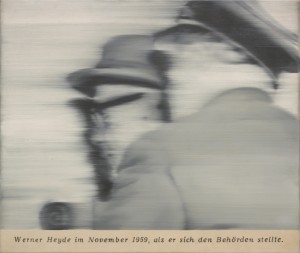 |
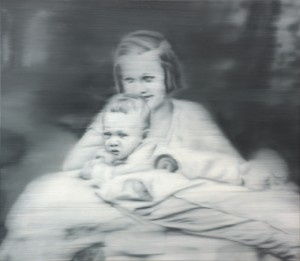 |
Nella settima sala, invece, sono esposti “Kerze” (1982) e “Schädel” (1983). I curatori, nella loro presentazione della stanza, dicono bene che siamo difronte a una sincera meditazione sulla “vanitas”. Eppure i due quadri non sono accostati e sono posti in punti non strategici (nel catalogo invece le due immagini sono accostate).
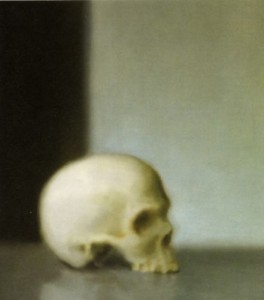 |
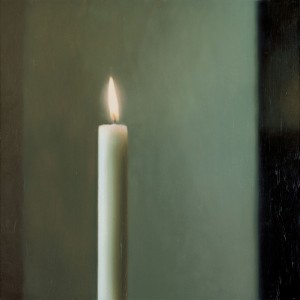 |
In catalogo sono riportati una serie di quadri del 1995 relativi alla nascita dell’ultimo figlio di Richter: una serie commovente di otto immagini che sono un grandioso inno alla maternità. Bene: in mostra non ci sono. Immagino ci saranno a Berlino o a Parigi. Peccato non averli visti dal vivo.
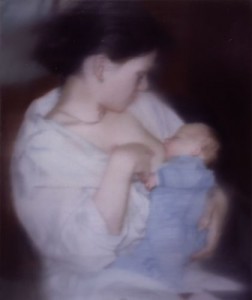 |
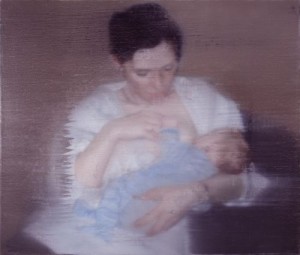 |
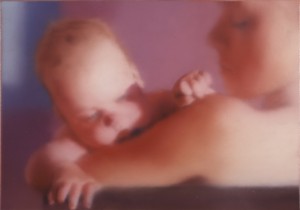 |
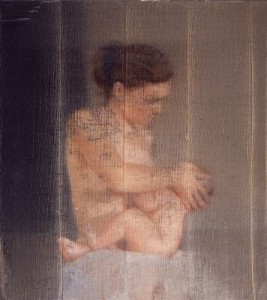 |
Ultimo: il quadro “September” (2005) nell’ultima stanza è esposto come uno tra gli altri come se non si trattasse di una delle sfide più azzardate con cui Richter si sia confrontato negli ultimi dieci anni.
Ecco invece le cose che mi sono piaciute.
La prima stanza con il primo quadro “ufficiale” (CR:1) tratto da un’immagine di un tavolo trovata sulla rivista Domus. Un quadro che ha dentro di sé il destino di tutta l’opera di Richter.

Lo straordinario “Neger (Nuba)” (1964) tratto da una foto di Leni Riefenstahl che è il primo photopainting a colori in mostra.

Il fatto che i curatori insistano molto sulla riflessione “in opera” che Richter svolge sulla pittura e il suo rapporto decisivo con l’opera di Duchamp.
Grande il trittico delle tre nuvole “Wolken” (1970).
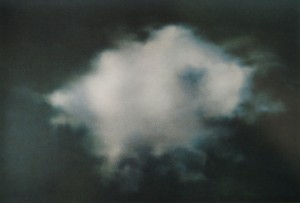 |
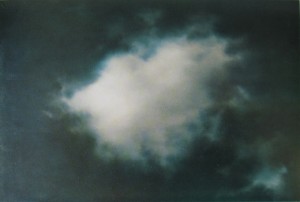 |
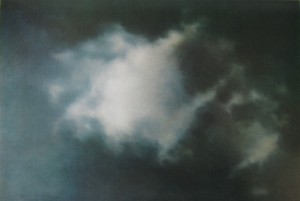 |
Alcuni quadri astratti scelti sono davvero da capogiro come quello del 1997 (CR:849-2).
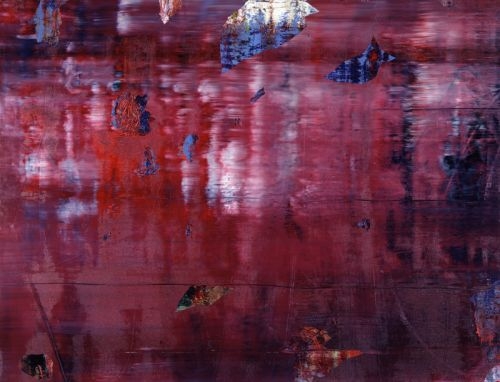
E infine: la stanza più clamorosa è quella dedicata al ciclo “Oktober” del 1989. Per intensità, maestria e portata storica.
Un ultima cosa: quel che mi colpisce di più leggendo le interviste di Richter è la sua insistenza a sottolineare il suo orientamento anti-ideologico che, a tratti, appare a sua volta ideologico. La sua volontà di andare contro corrente sempre lo ha portato, paradossalmente, a svolgere il ruolo di paladino della forma d’arte che durante l’ultimo secolo è stata data tante volte per morta: la pittura. Il suo metterne in luce i limiti (come nel corpo a corpo con l’Annunciazione di Tiziano) lo ha portato a scoprirne le frontiere e allo stesso tempo il valore di mezzo di comunicazione contemporanea. Il fatto che ancora oggi, a ottant’anni, Richter continui a dipingere e a inventare cose nuove (vedi la mostra in corso a Parigi) dimostra che questo lavoro di ricerca non è ancora finito.The exhibition by Gerhard Richter at the Tate Modern is an unforgettable. I knew that before, since this is the first major retrospective on the German painter, but confirmation has not been without its surprises. Memorable because the Richter magnitude has the space to unfold despite the limitations that an exhibition such as the Tate inevitably brings.
The exhibition has an educational trend, chronologically correct, but withdraws or has not been able, where possible, to explode at some explosive issues inherent in the art of Richter.
I make four examples:
the first is in the second room, when the relatonship etween “Herr Heyde” (1965) and “Tante Marianne” (1965) is not valued. The first painting, in fact, shows the arrest of chief of eugenics policy during the Nazi regime, while the second is the reproduction of an image in which Richter’s child is held in the arms of Aunt Marianne, a victim of that very policy. The paintings are on display at a short distance, but as if among them there was no direct relationship.
 |
 |
In the seventh room, however, are exposed “Kerze” (1982) and “Schadeli” (1983). The editors, in their presentation of the room, say that we are in front of a sincere meditation on the “vanitas.” Yet the two paintings are juxtaposed and are placed in non-strategic points (in the catalog instead of the two images are touching).
 |
 |
The catalog shows a series of paintings of 1995 relating to the birth of the last son of Richter: moving a series of eight images that are a great hymn to motherhood. Well, they are not on display. I imagine there will be in Berlin or in Paris. Too bad not having seen them live.
 |
 |
 |
 |
Last: the painting “September” (2005) in the last room is exposed as one of the others as if it were not one of the most daring challenges with which Richter has been compared in the last ten years.
Here is the things that I liked:
The first room with the first “official” painting (CR: 1), an image taken from a table found on the magazine Domus. A framework has within himself the destiny of Richter’s whole work.

The extraordinary “Neger (Nuba)” (1964) a photopainting taken from a photo of Leni Riefenstahl which is the first color in the exhibition.

The fact that the editors insist on much reflection “work” that plays on the Richter painting and its relationship with the critical work of Duchamp.
The triptych of the three great clouds “Wolken” (1970).
 |
 |
 |
Some abstract paintings chosen are truly mind-boggling as that of 1997 (CR :849-2).

And finally, the most dramatic room is dedicated to the cycle “Oktober” in 1989. For strength, skill and historical significance.
One last thing: what strikes me most reading the interviews Richter is his insistence to emphasize its anti-ideological orientation that, at times, appears to turn ideological. His willingness to go against the tide always led him, paradoxically, to play the role of champion of the art form during the last century has been given up for dead many times: painting. His highlight the limits (as in combat with the Annunciation by Titian) led him to discover its borders and at the same time the value of contemporary media. The fact that even today, eighty years, Richter continued to paint and invent new things (see the current exhibition in Paris) demonstrates that this research work is not finished yet.
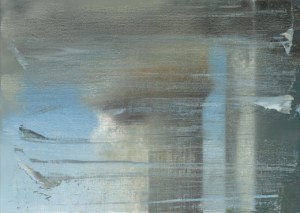

ciao luca, molto bello il blog, sento che hai una vera passione per l’arte, guarda questo link http://www.robertozizzo.com scusa se sono di poche parole mi esprimo meglio per immagini (nella sezione con i punti interrogativi ci sono i lavori degli ultimi anni ciao roberto.
http://www.robertozizzo.com